Welcome to History’s Greatest Teams, our retrospective on, well, the greatest teams in soccer history. Did you know association football is over 150 years old? Somehow it is, and over that time, certain teams have risen to the top. Whether it’s a club or national team, The Center Circle thought it would be interesting to look back on those illustrious squads. If you’d like to see a team highlighted in History’s Greatest Teams, go ahead and comment below.
1974 Netherlands
The Germans didn’t even touch the ball and they were down 1-0. That’s how the 1974 World Cup Final began, when the Netherlands national team waged Total Football on the host team. Armed with their distinctive style and its muse, Ballon d’Or winner Johan Cruyff, the Dutch had cruised through the tournament.
But now they had run up against a West Germany squad stacked with talent. Despite spellbinding the Germans to a second minute goal, the Dutch would concede two before the first half was out. The Oranje scrambled for an equalizer in the second, but nothing materialized.
Thus, the greatest team to never win a World Cup was born. But let’s back up to 1965 to take in the whole picture.
The General
Total Football didn’t just spontaneously emerge from the football ether. Its originator and mastermind was Rinus Michels, the legendary Dutch manager. In 1965, he took over for Netherlands’ club team Ajax, who were in the thick of a relegation battle. Michels, a 12-year Ajax player, avoided the drop and then levitated his old club to ridiculous heights. They won the league four out of the next five seasons, a magnificent turnaround from their pathetic state just a few years prior.
Of course, it helps that Michels had Cruyff by his side. Genius coaches don’t find success unless they have the right players around them – and Michels had the platonic ideal of totaalvoetbal in the young Cruyff.
Together the two created a tactical system that was counterintuitive and revolutionary. By allowing Cruyff’s tremendous talent to freely roam the field and undress opposing defenses, Michels’ best player wasn’t just restricted to a singular position. In fact, Total Football’s strategy didn’t just grant that right to Cruyff, but the entire team. For it to work properly, a player who moves out of position is replaced by a teammate, making anyone an attacker or defender. Pressure on the ball and finding space where the defense gives it were two of the main tenets. As you can imagine, this fluidity demands insane levels of intelligence, versatility, and fitness. Nicknamed “The General”, Michels cultivated creativity and coherence, whether he was managing Ajax or the Netherlands national team.
After guiding Ajax to their first European Cup title in 1971, Michels decided he wanted to upgrade his managerial philosophy and skills to FC Barcelona in Spain. Although he would find success there, nothing he achieved from that point on could touch those unbeatable Ajax teams. During his stint with Barca, he stepped in at the last minute to manage the Dutch national team in 1974.
Cruyff, the Conductor
How does the arguably the greatest European player of all-time only appear in two major international tournaments and never win? Easy, just leave all witnesses of your skill in awe. When former players speak about him, words like “genius” and “heart of a revolution” pop up without hyperbole.
That’s not to say that Cruyff’s teams weren’t successful. He joined Ajax’s youth system in 1957, at ten years of age. By 1964, young Johan began his senior career, matching up his early years with the arrival of Michels. It’s amazing when an innovative creative mind finds his perfectly talented muse; we’re talking Martin Scorsese with Robert De Niro-level greatness here. Cruyff followed his manager to Barcelona in 1973. Right before the ’74 World Cup, the two led the Catalans to their first La Liga title since 1960.
I’m too young to have seen Cruyff in his day, but I’ll cop to having a love affair with old YouTube clips of him. He simply did things that no one thought was possible, whether it was the Phantom Goal in 1973 for Barcelona or the Cruyff Turn during the World Cup, his inventiveness was notable for its purpose, not just the style. Unlike Brazilian stars like Garrincha, he didn’t embarrass defenders and then circle back to do it again like AND1 Streetball on grass. Cruyff always had the remarkable mix of elegant flair and practical substance, which made him the ideal conductor of the Total Football machine.
In fact, even the jersey number he wore was highly unprecedented. Coming back from an injury in 1970, his usual number 9 was taken by a teammate, so he put on 14 instead. Back then, it was atypical for starters to wear a shirt number that wasn’t 1 to 11. Cruyff became number 14 from then on.
Clockwork Oranje
To run this complex machine right, you needed a team chock-full of versatile and intelligent athletes. Fortunately, the Netherlands had this in spades during the mid-70s. And yet, the Dutch hadn’t qualified for the World Cup since 1938, so there was no much-adorned history to look back upon. These guys were carving their own place in Netherlands football lore.
In 1974, most of them played for two of the Eredivisie’s biggest clubs, Ajax and Feyenoord. Attacking midfielder Johan Neeskens was an Ajax man. Nicknamed Johan II (for obvious reasons), Neeskens never scored like the other Johan, but his skill made him an important piece.
Starting Dutch goalkeeper Jan Jongbloed still holds the record for most Eredivisie games played with 707 (!). Known as a “sweeper keeper” long before Manuel Neuer, he was in between the pipes for both the ’74 and ’78 World Cups.
The wings were held down by Johnny Rep, the lethal right winger, and Rob Rensenbrink, a pivotal left winger who found prolific success with Belgian club Anderlecht.
Finally, the most indispensable defensive piece was easily Ruud Krol. An all-around talent, he was deployed at left back, but allowed to maraud up the field to create scoring chances.
Michels lined his men up in a 4-3-3, but that was just a formality, really. Rep and Rensenbrink moved up and down their flanks, while surges forward from Krol and other fullbacks were welcome to add more options. In the first round (back then there were two sets of group stages), they overwhelmed Uruguay and Bulgaria. Even a draw with Sweden couldn’t keep them from topping their group.
In the middle of it all, Cruyff confidently orchestrated the movement. The highlights of a second round 4-0 evisceration of Argentina show Cruyff all over the field: scoring early from center forward, lobbing in a pitch-perfect cross from the far left side for their third goal, punching in a score from an extreme angle for the final nail in the coffin.
After taking out the East Germans 2-0, they would submit their most impressive feat yet as a footballing country. In the final match of the second group stage, they met Brazil in what essentially functioned as a semifinal. The Brazilians were the defending World Cup champs, including three of the last four tournaments. This time they were Pele-less, yet they still had that intimidating panache. Neither team wore their national team’s usual colors – yellow for Brazil, orange for Netherlands – and that turned out to be a symbolic foreshadowing. When two sides who play with such beauty and grace meet, you expect it to be the equivalent of staring at Michelangelo’s Sistine Chapel for two hours. That’s not what happened. The blue-shirted Brazilians and the white-clad Dutch hacked and grabbed at each other the entire match, creating one of the more unexpected roughhouses in history. Joga Bonito, this was not.
Despite all of the carnage, the Netherlands were still able to display their class over the keeper. Fifteen minutes later, Krol arced a ball to the streaking Cruyff in the middle of the box. With a leaping right-footed stab, he delivered the second goal. The Dutch were on to the World Cup final.
In a final packed with unbelievable ability, it began with the unreal drama of Cruyff zigzagging into the box and getting chopped down by West Germany. Neeskens went to the spot and slammed home the first penalty shot in World Cup finals history. However, in the 25th minute the Germans knotted the match when they were awarded a penalty themselves. Just before half, Bayern Munich striker Gerd Muller struck to give West Germany the lead they would not relinquish. At home in Munich, the German defense refused to fall under the spell of the magical Dutch attack. Total Football had crashed out just shy of glory.
Heartbreak, Redemption, and a Fascinating Legacy
Four years later, a Netherlands squad without Cruyff or Michels traveled all the way back to the World Cup finals, which is a testament to the country’s soccer prowess. However, heartbreak on the world’s biggest stage returned like a specter when host country Argentina scored two goals in extra time to take the title.
Ten years after that in the 1988 Euros, redemption finally arrived. Michels, back coaching the national team, exacted revenge on West Germany in the semis before leading the Dutch to their first, and only, international trophy. Unlike the swaggering 70s Dutch, this Netherlands team had attacking power but employed a more physical presence. In the 2010 World Cup, the national team would drift even further from their totaalvoetbal roots. In their drive to the finals, this new generation had no problem thuggishly smacking their opponent in the mouth, even if they still had Robin van Persie and Wesley Sneijder creatively operating the attack.
So, if Netherlands soccer hasn’t carried the torch from their own Total Football days, why are we still so captivated by it?
First of all, it clearly changed the game. While the exact same tactics don’t exist today, you can see the fingerprints all over our game. Most visibly, FC Barcelona and Spain’s tiki-taka style of high pressing, hypnotic passing, and a heavy reliance on technical skill all hearken back to the ’74 Dutch. This has everything to do with former Barca manager Pep Guardiola playing for Cruyff on those 90s Barca teams and instilling a form of Cruyff’s mentality as a coach over a decade later. Guardiola’s teams (first Barca from 2008-12, now Bayern) have a natural grace and attractiveness that also wins a mass of games.
But beyond the inspiring intellect and visceral beauty of the style, I think the fact that the ‘74 and ’78 teams fell agonizingly short has something to do with it. If either of those teams won, the mid-70s Dutch would be minted in history as an inarguably immortal system. Without a World Cup title to point to, they become a more fascinating study. There is something identifiably human about failing in such a pivotal moment. We resonate with that.
Or maybe they were just pretty to watch, I don’t know.


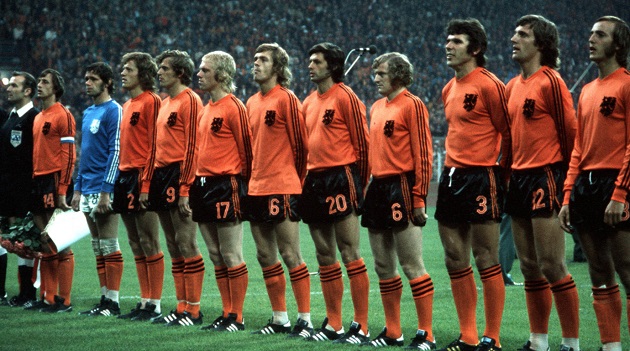
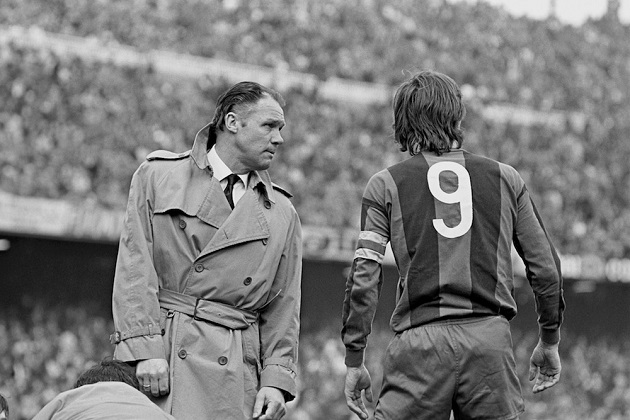

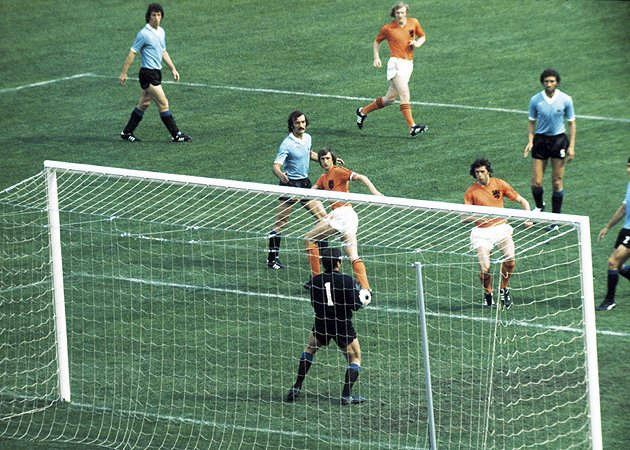


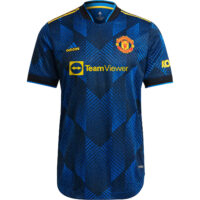
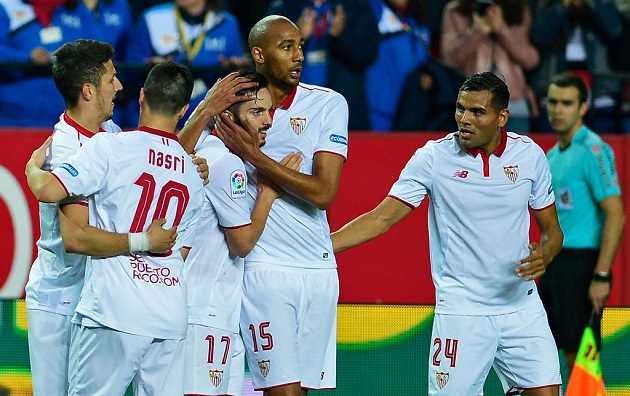
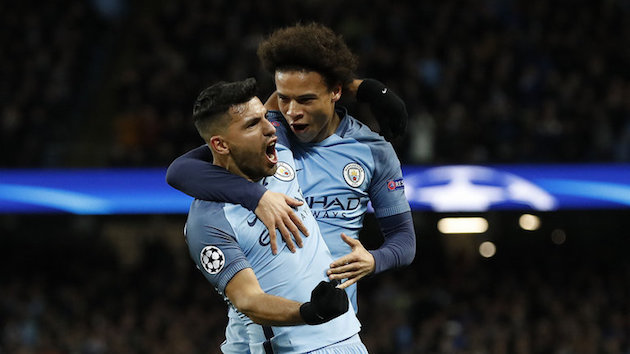
at 20:32
There’s a lot of nostalgia too because the 1970s Dutch team was really Dutch and European. Better times.
at 18:22
great story form the legend